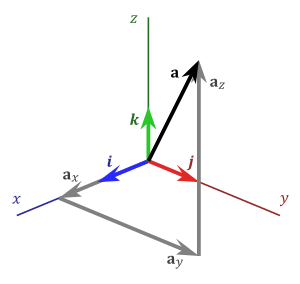Eddington number

In mathematics, the standard basis (also called natural basis or canonical basis) for a Euclidean space is the set of unit vectors pointing in the direction of the axes of a Cartesian coordinate system. For example, the standard basis for the Euclidean plane is formed by vectors
and the standard basis for three-dimensional space is formed by vectors
Here the vector ex points in the x direction, the vector ey points in the y direction, and the vector ez points in the z direction. There are several common notations for these vectors, including {ex, ey, ez}, {e1, e2, e3}, {i, j, k}, and {x, y, z}. These vectors are sometimes written with a hat to emphasize their status as unit vectors. Each of these vectors is sometimes referred to as the versor of the corresponding Cartesian axis.
These vectors are a basis in the sense that any other vector can be expressed uniquely as a linear combination of these. For example, every vector v in three-dimensional space can be written uniquely as
the scalars vx, vy, vz being the scalar components of the vector v.
In -dimensional Euclidean space, the standard basis consists of n distinct vectors
where ei denotes the vector with a 1 in the th coordinate and 0's elsewhere.
Properties
By definition, the standard basis is a sequence of orthogonal unit vectors. In other words, it is an ordered and orthonormal basis.
However, an ordered orthonormal basis is not necessarily a standard basis. For instance the two vectors,
are orthogonal unit vectors, but the orthonormal basis they form does not meet the definition of standard basis.
Generalizations
There is a standard basis also for the ring of polynomials in n indeterminates over a field, namely the monomials.
All of the preceding are special cases of the family
where is any set and is the Kronecker delta, equal to zero whenever i≠j and equal to 1 if i=j. This family is the canonical basis of the R-module (free module)
of all families
from I into a ring R, which are zero except for a finite number of indices, if we interpret 1 as 1R, the unit in R.
Other usages
The existence of other 'standard' bases has become a topic of interest in algebraic geometry, beginning with work of Hodge from 1943 on Grassmannians. It is now a part of representation theory called standard monomial theory. The idea of standard basis in the universal enveloping algebra of a Lie algebra is established by the Poincaré–Birkhoff–Witt theorem.
Gröbner bases are also sometimes called standard bases.
In physics, the standard basis vectors for a given Euclidean space are sometimes referred to as the versors of the axes of the corresponding Cartesian coordinate system.
See also
References
- 20 year-old Real Estate Agent Rusty from Saint-Paul, has hobbies and interests which includes monopoly, property developers in singapore and poker. Will soon undertake a contiki trip that may include going to the Lower Valley of the Omo.
My blog: http://www.primaboinca.com/view_profile.php?userid=5889534 (page 198)
- 20 year-old Real Estate Agent Rusty from Saint-Paul, has hobbies and interests which includes monopoly, property developers in singapore and poker. Will soon undertake a contiki trip that may include going to the Lower Valley of the Omo.
My blog: http://www.primaboinca.com/view_profile.php?userid=5889534 (page 112)












